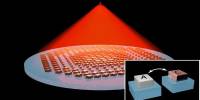Singlet fission (SF) is an exciton amplification process in which two triplet excitons are formed from a singlet exciton produced by the absorption of a single photon in chromophores. A group of researchers revealed that SF can be enhanced by introducing chirality and altering chromophore orientation and arrangement. Their groundbreaking research is likely to further numerous applications in energy science, quantum and information materials science, photocatalysis, solar cells, and life science.
In organic molecules, an exciton is a particle-bound pair consisting of an electron (negative charge) and a hole. They are bound together by Coulombic attraction and can migrate within molecular assemblies. Singlet fission (SF) is the process by which an exciton is amplified, resulting in the formation of two triplet excitons. This is created by the absorption of a single light particle, or photon, by molecules known as chromophores. Controlling the molecular orientation and arrangement of chromophores is critical for achieving high SF efficiency in materials with great potential for optical device applications.
So far, SF research have been undertaken in solid materials, but there are still no comprehensive design recommendations for the molecular organization required for efficient SF.
Our research offers a novel framework for molecular design in SF research and will pave the way for applications in energy science, quantum materials, photocatalysis, and life science involving electron spins.
Professor Nobuo Kimizuka
Professor Nobuo Kimizuka and his colleagues from Kyushu University have now successfully demonstrated that SF can be promoted by introducing chirality (molecules that cannot be superimposed on their mirror images) into chromophores and achieving chiral molecular orientation in self-assembled molecular structures. Publishing in Advanced Science, the team showedSF-based triplet excitons in self-assembled aqueous nanoparticles containing chiral π-electron chromophores, a phenomenon not observed in similar racemic nanoparticles (a mixture of equal amounts of molecules that are mirror images of each other).
Kimizuka says, “We have discovered a novel method to enhance SF by achieving chiral molecular orientation of chromophores in self-assembled structures.”

The researchers looked on the SF properties of aqueous nanoparticles that self-assembled from tetracene dicarboxylic acid ion pairs and different chiral or non-chiral amines. They discovered that the counterion (an ion with the opposite charge as another ion in the solution), specifically the ammonium molecule, played an important function. The counterion had an impact on the molecular orientation of the ion pairs, structural regularity, spectroscopic characteristics, and the intensity of intermolecular coupling between tetracene chromophores. Thus, the counterion was critical in directing the alignment of the chromophores and the resulting SF process.
Through extensive experimentation with chiral amines, the team achieved a triplet quantum yield of 133% and a rate constant of 6.99 × 109 s−1. In contrast, they observed that nanoparticles with achiral counterions did not exhibit SF.
The racemic ion pair also produced an intermediate correlated triplet pair state by SF. However, triplet-triplet annihilation was dominant in the triplet pairs; therefore, no dissociation into free triplets was observed.
“Our research offers a novel framework for molecular design in SF research and will pave the way for applications in energy science, quantum materials, photocatalysis, and life science involving electron spins. Furthermore, it inspires us to continue exploring SF in chiral molecular assemblies in organic media and thin film systems, which are critical for applications in solar cells and photocatalysts,” concludes a hopeful Kimizuka.
















